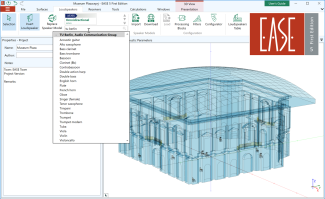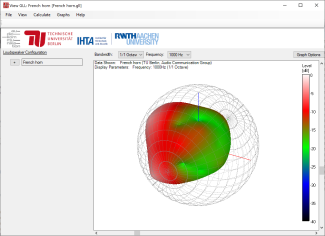Technische Universität Berlin and AFMG publish high-resolution EASE GLL data for 22 musical instruments

Berlin, June 4th, 2023. While a large, high-resolution database is available for most professional loudspeakers and line array systems, high-quality data for natural sound sources is generally difficult to find. Musical instruments are of particular interest for various types of acoustic simulation, especially when considering concert setups and performance spaces.
In a groundbreaking research project spanning several years, the Audio Communication Group at the TU Berlin and the Institute for Hearing Technology and Acoustics at the RWTH Aachen University have collaborated to produce data sets for more than forty contemporary and historical instruments. These include a clarinet, a harp, a trumpet, and a violin, among others. Directional data was obtained in an anechoic environment by recording all notes with a 32-channel spherical microphone array completely surrounding the musician. Sound power data was recorded simultaneously for each instrument. Spatial upsampling to a 5°/5° grid was performed using spherical spline interpolation.
With the support of AFMG, GLL data files have now been compiled using these unique data sets. Special care has been taken to ensure that the data is properly adjusted and calibrated for use in modeling software. The directivity balloon was derived from the average radiation over the full frequency range of the instrument, determined from the individual tones.

The simulated SPL output was calibrated to the measured sound power averaged over the full radiation sphere and frequency range of the instrument. Finally, the modeling results were cross-checked and verified in EASE.
Prof Dr Stefan Weinzierl, Head of Department, explains:
"This was a long project with many challenges, from logistics to measurement and subsequent digital signal processing. However, the results have been really good in the end and now unlock many applications and new developments. The research project will be described in more detail in a JAES article to be published shortly.”
AFMG's Managing Director, Dr Stefan Feistel, adds:
"We were very pleased and grateful to be able to support the research group in the final step of this great project. These interesting and innovative data sets will be very helpful for many of our users, including acoustical consultants and engineering firms. We invite users and researchers alike to take a close look and contact us with any comments or questions.”
The GLL data files have been published recently on AFMG’s website for use in EASE 5-FE, the new EASE platform for room acoustic simulation and sound system modeling. They are provided free of cost as part of the continuous feature upgrades that AFMG delivers to all EASE 5-FE users.
- Download the data from the AFMG website, TU Berlin section (Brands 'T').
- Detailed information about the research project has been published as a preview version of an article submitted to the JAES.
Earlier related works are available here and here. - Contact us for questions.
Read more about the new tools and workflows of EASE 5-FE ! >>
Important Note
EASE 4 users upgrading to EASE 5 will retain their existing EASE 4 license. In this manner, the transition to the new platform can happen smoothly and will take into account already running projects.